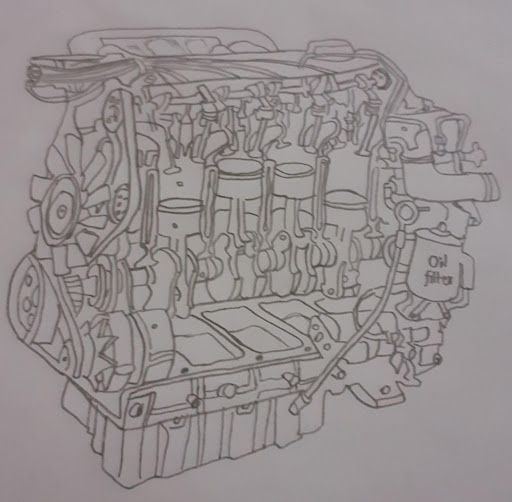The Internal Combustion Engine

Imagine a world without vehicles. I know it's impossible to.
Well, without engines and vehicles, we can't function properly or work at all. An engine is defined as 'A machine with moving part that converts power into motion. You see, an internal combustion engine is the most common form of heat engines. They are used in many vehicles like boats and ships. Why are they named this? They are named this because their fuel is ignited in such a way for it to do the work inside the engine. The purpose of the internal combustion engine is to generate mechanical power that is contained in the fuel and is released through the combustion of the fuel inside the engine. Concluding the internal combustion engine is a very great discovery in the history of humanity and a very big impact and important aspect of our daily lives.
Holding my mother’s hand to cross the road, my eyes saw the scene of many vehicles driving, going to the places they needed to. As some motorcycles, cars, and trucks stopped, my eyes caught the vision of the vehicle’s engine due to the smoke coming out of it. Ever since then, though I was never interested in anything related to engineering, I wondered how they worked. Have you ever wondered how they worked?

Imagine a world without vehicles; I know it's impossible to. Well, without engines and vehicles, we can’t be here and there (briefly, it can’t function/work without an engine). So even if we don’t have the time to really care about this, we should seriously appreciate it.
Firstly, what is an engine? An engine is defined as ‘’A machine with moving parts that converts power into motion’’.
Now, what is an internal combustion engine? You see, an internal combustion engine is one of the most common forms of heat engines, and they are used in vehicles (e.g., boats, ships, aeroplanes, trains). But why are they called an ‘’internal combustion engine’’? They are named this because their fuel is ignited in such a way for it to do the work inside the engine. Then this same fuel and air mixture would be emitted as exhaust. This would be done by something called a piston (known as a reciprocating engine), or even a turbine could be used.
How are these heat engines used? Or how do they work? As explained above, it is a basic chemical process of releasing energy in a fuel and air mixture. Now the ignition and combustion of the fuel only occur within the engine itself (as said before). Partially this then helps the engine convert the energy from the combustion to work. Also consists of a fixed cylinder and a moving piston. In the engine, the expanding combustion gases push the piston, which then in turn rotates the crankshaft. Ultimately, through a sort of system of gears in the powertrain, this motion finally helps drive the vehicle’s wheels. Of course, the internal combustion engine works with some sort of principle. This principle is called ‘’The Ideal Gas Law’’.
Looking into more about the ‘’Ideal Gas Law’’. It raises the temperature of a gas and as well increases the pressure that makes the gas expand. The internal combustion engine has a chamber that turns the turbine. By attaching the piston or a turbine to the camshaft. This causes the engine to be able to convert a portion of the energy input to the system to do its useful work. To compress the piston in the engine, it exhausts the gas. Moving on, a heat sink is used to keep the system running at a consistent temperature. The gas turbine, which does consistently use combustion, simply exhausts its gas continuously rather than in a cycle.
The purpose of the internal combustion engine is to generate mechanical power from chemical energy that is contained in the fuel and is released through the combustion of the fuel inside the engine. The importance of this fascinating engine is that it provides amazing drivability and durability, with more than 250 million highway transportation vehicles in the United States alone. Along with gasoline and diesel, the engine can utilise alternative fuels (like Biodiesel, Ethanol and many more).
Concluding the internal combustion engine is surely a very useful discovery in the history of humanity. And it is used every day for travelling. I hope that you would appreciate such things and look further into things like this. I also hope you understand what an internal combustion engine is, how it works, why it's important, and its purpose.
References
www.energy.gov
www.thermopedia.com
www.energyeducation.ca
Author biography
Aishath Rausam Mohamed Rauf is 13 years old and is set to enter seventh grade after completing the sixth. She and her family are residents of Male', the Maldives. She has a long list of interests and loves to try new things. But she enjoys writing, reading, watching movies, and editing videos the most. She spends most of her time reading and writing fantasy and mystery literature, and she enjoys watching horror or mystery films. She loves to help others and is by nature a very social person. Her current top priorities are to finish writing her story and become a school prefect.

Cite this article as:
Aishath Rausam Mohamed Rauf, The Internal Combustion Engine, theCircle Composition, Volume 2, (2022). https://thecirclecomposition.org/the-internal-combustion-engine/
